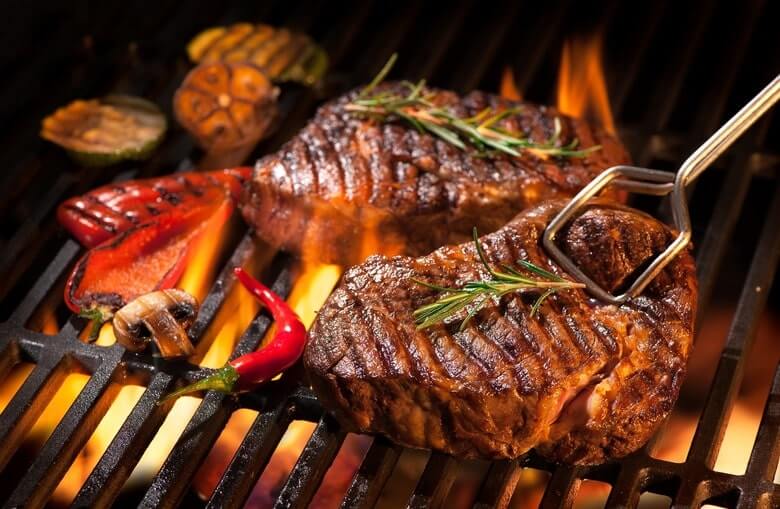
It took me many trips to different butcher shops and several iterations in the kitchen before I reached a level of satisfaction with my grilled steak, a level that would be compared to when I was visiting famous steakhouses. The formula for grilling your perfect steak involves three parameters: the steak cut, seasoning, and cooking process.
There are many criteria that you should consider while choosing your steak cut; one of them is the origin of the steak (e.g., Brazilian beef, Australian beef, or the so-called "local" beef here in the UAE). Again, choosing a steak of a certain origin is subject to personal taste.
The type of steak cut is the main factor in achieving a satisfactory experience when grilling steak at home. Depending on the amount of fat and the way it is distributed, the steak cut will have varying tenderness and flavor. There are four common types of steak cut on any steakhouse menu
Often referred to as "filet mignon," it is the most expensive cut of steak for its mild taste and the least amount of fat included. It is my favorite choice.
Often referred to as "top sirloin". This cut is less tender compared to tenderloin, with some fat marbling throughout, giving it a good beefy flavor.
I consider it the best choice for a hardcore "carnivore." It is sold with a T-shaped bone in, with meat on both sides. This cut has generous fat marbling throughout, making it super-tender and juicy, with a beefy taste
Known colloquially as "entrecôte." This cut is basically a prime rib cut down into individual steaks. It has lots of fat marbling the meat and large pockets of fat interspersed throughout, making it extra juicy with a flavorful beefy taste.
Regarding seasoning, a real steak fan would prefer having his or her steak taste outstanding, which is why I recommend using only a little pinch of pepper and sea salt for seasoning a steak piece and leaving it for fifteen minutes before grilling. Once your steak is ready for eating, you can enjoy the diversity of sauces and toppings available in the market and at any steakhouse, but for grilling use only pepper and sea salt
When it comes to the cooking process, there are two main styles: charcoal grilling and pan grilling. Pan grilling involves fewer parameters to control and is easier to master. In this article, I will focus on what I have real experience with, which is pan grilling.
For pan grilling, you need mainly three items (in addition to a good piece of steak): a pan, greaseable material, and a steak tong.
I recommend using a non-stick pan, with adequate size allowing enough space around the steak piece. For greasing, you can use normal frying oil or, better yet, grilling spray, which is easier to spread all over the pan. When it comes to steak tong, it is recommended to choose one that is big enough to carry the steak piece steadily, but not too big to make it difficult to turn the steak piece around while being grilled.
One thing you should learn is different ways to cook steak. Cooking style, referred to as "steak doneness," impacts the color and tenderness of a steak piece and its taste as well. In general, leaving a piece of steak on the fire for a longer period of time will turn it darker in color and make it more difficult to touch. There are five common steak cooking styles
I consider this the cooking style for real "carnivores." The piece of steak is nearly raw. A rare steak is browned around the sides, and bright red in the middle.
Most of the center of the steak piece should be pink in color with a hint of red. The sides should be well browned, the top and bottom caramelized to a dark brown color with good grill marks.
This is the most commonly accepted level of completion. I recommend grilling with this style when cooking for a dish party or a family gathering. The piece of steak will have a thick band of light pink through the middle, but more brown than pink. The sides should be a rich brown color and the top and bottom charred darkly, but not black.
This is my preferred level of doneness, with only a hint of pink in the very middle of the piece of steak. The surface should be a dark brown with good charring on the top and bottom. This steak will be very stiff but still have a slightly spongy feel in the center.
For real steak fans, this is the less popular doneness level. On the other hand, this is the most popular choice for people who eat steak occasionally and feel more comfortable with the "Safe" choice. This level of doneness is achieved only by slowly cooking the piece of steak at a relatively low temperature till there is no trace of red or pink at all, while the outside is brown with no traces of burns.
In order not to complicate things, I would not give hints about the duration to grill each side of the steak piece, and at what temperature for a certain thickness or specific steak cut. I will explain to you an easier method, referred to as the "Finger Test," to be used while cooking a piece of steak, to know whether it has reached a certain doneness level.